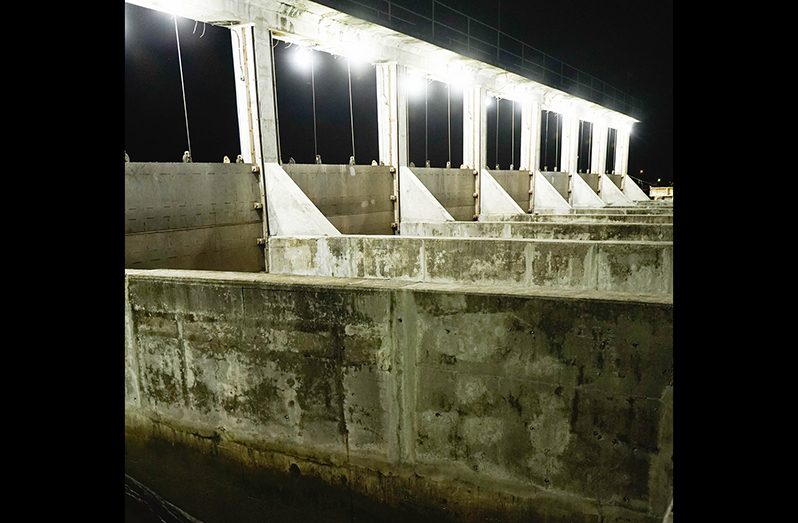— gov’t mulls establishment of similar structures countrywide
HAD it not been for the Northern Relief Channel constructed at Hope/Dochfour, East Coast Demerara, the majority of villages on the coastland would have been devastated with flood waters, much like it was in 2005, when boats had become the main form of transportation.
This affirmation was given by a number of government officials, including the President himself, Dr. Mohamed Irfaan Ali, who reminded that following Guyana’s infamous floods 15 years ago, the People’s Progressive Party/Civic (PPP/C) government, under the leadership of then President and current Vice-President, Dr. Bharrat Jagdeo, conceptualised what is widely referred to as the Hope Canal Project.
It is a massive, multi-component channel which utilises a sturdy, eight-gated sluice to release excess water into the Atlantic Ocean, at times when the East Demerara Water Conservancy (EDWC) reaches maximum capacity. The conservancy is basically a reservoir that holds up to 582 square kilometers of fresh water; its earthen embankment could become susceptible to overtopping.
The $3.6 billion ‘Hope Canal Project’ subsequently came on stream, and was greeted with a host of criticisms from the Parliamentary Opposition. Ever since the structure was put to the test in 2015, authorities had lauded the channel’s capabilities of drastically lowering water levels in the overburdened conservancy, which is was also being served by an insufficient release channel located at Land of Canaan, East Bank Demerara.
On Sunday night, President Ali visited ‘Hope Canal’ as part of his ongoing efforts to ensure that all is being done to tackle the ongoing floods. “If this canal was not here now, the East Coast [of Demerara] would have been under water,” President Ali recognised.
Over the past week, a number of communities outside of Region Four have been severely affected by flooding.
NEED TO REPLICATE
Reaffirming the critical role that the ‘Hope Canal’ has played in safeguarding the coastland from devastating floods, President Ali cited the need for similar waterways to be constructed in various parts of the country. “We may have to replicate in Berbice and other areas… thankfully, we have this facility here and this has helped us tremendously,” President Ali said last night.
During his inspection, President Ali found that all eight doors of the Hope/Dochfour sluice were open, and that excess water which threatened the livelihoods of hundreds of residents, was being released, unhindered, into the Atlantic Ocean. “These floods and the rainfall have nothing to do with politics. The rain does not decide where it would fall or whose home would be flooded. This is an issue we have to deal with as Guyanese,” President Ali asserted.
The Head of State was accompanied on his inspection run by Head of the National Drainage and Irrigation Authority’s (NDIA) Board, Lionel Wordsworth, who, along with former Agriculture Minister, Dr. Leslie Ramsammy, initially spearheaded the construction efforts of the project.
In an interview with the Guyana Chronicle on Sunday evening, Dr. Ramsammy was happy with regard to the operations of the Northern Relief Channel. He said that under his tenure, efforts had begun to construct a similar structure which would eliminate perpetual flooding being experienced in Black Bush Polder, Region Six (East Berbice – Corentyne).
The PPP/C government, in 2013, had commenced the construction of a $400 million two-door koker intended to serve the areas of Bengal and Johanna which have been highly susceptible to flooding.
In light of what is happening in Regions Nine and 10, Minister of Agriculture, Zulfikar Mustapha, said that infrastructural solutions are currently being examined. He informed that more drainage channels, similar to ‘Hope Canal’ may have to be constructed to ensure that communities all across Guyana are safeguarded from any threats of flooding.
“We have to look at it in a long-term; we have to do a lot of studies into that at Kwakwani and other low-lying and riverine areas,” minister Mustapha said.
He indicated, too, that the Agriculture Ministry is in the process of procuring a $497 million dredge to construct and later maintain permanent channels and outfalls. This, he said, would heighten the capacity of the NDIA, and eliminate the need for companies and equipment to be outsourced.



.jpg)








